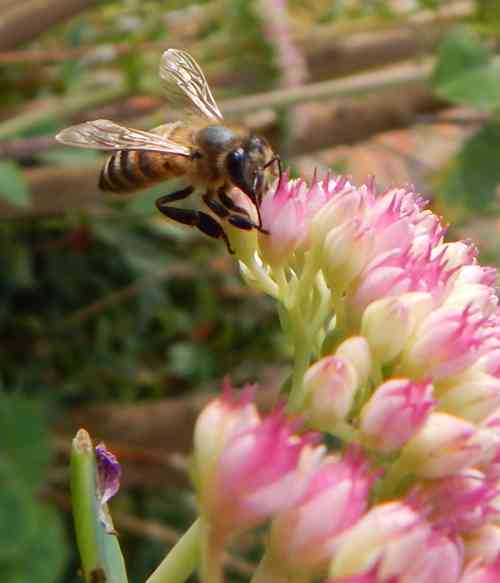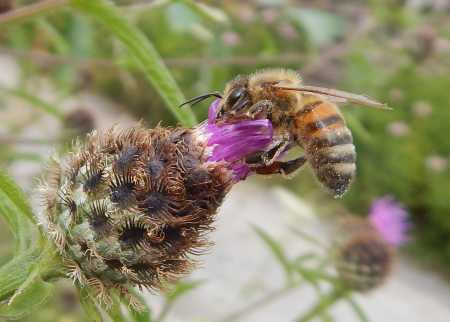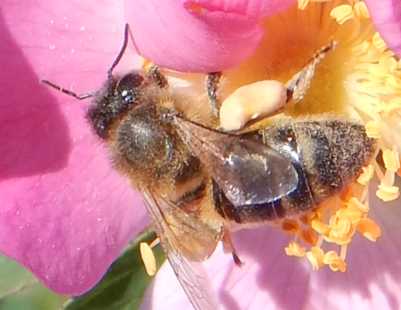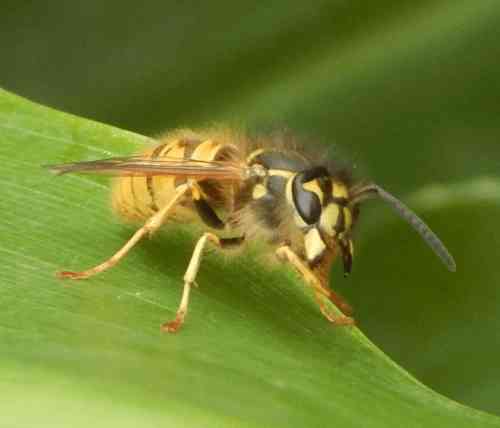Bees Can Detect Bombs!
Updated: 1st May 2021
Believe it or not, honey bees can be trained to detect bombs!
Yes, we are all aware of the use of sniffer dogs by the military and by police
forces to detect drugs and explosives, but it appears that it is possible for honey
bees to perform the same task.
How
do honey bees detect bombs?
Bees naturally extend their tongues (proboscis) in response
to food, and can be conditioned to do the same thing in response to a
particular stimuli.
Through ‘classical conditioning training’, bees learn to associate a particular smell with food, so that they automatically stick out their tongues.
In this instance then, honey bees are being trained to respond by sticking their tongues out when they sniff the aroma from explosives.
 Honey bee foraging on sedum.
Honey bee foraging on sedum.Honey bees in action
Initiatives of this kind have been popping up across the
world for some years.
For example, in the USA a group of scientists from the National Laboratory in Los Alamos, New Mexico published findings of a study in which honey bees had been trained to stick out their proboscis (tongue) if they could smell explosives (such as dynamite or C4 plastic explosive) in almost any item, ranging from cars to trouser belts.
Tim Haarmann (from the Los Alamos team) said the bees could be carried in hand-held detectors the size of a shoe box, and could be used to sniff out explosives in airports, roadside security checks, or even placed in robot bomb disposal equipment.
He said the next step would be to manufacture the bee boxes and train security guards in their use.
Meanwhile a UK company called Inscentinel Ltd based in
Hertfordshire, England, were also harnessing honey bees in the line of explosives detection, and actually created
such a device. Moreover, the company stated that bees could detect explosives
at the miniscule concentration of 78 parts per trillion for some molecules!
 Honey bee foraging on knapweed.
Honey bee foraging on knapweed.Once trained, the bees were placed into a specially designed cartridge that also contained a digital camera linked to image recognition software.
A sample of air was placed into the cartridge, and if the air sample contained explosives aromas, the camera and recognition software would detect the bee extending its proboscis.
Following the exercise, the honey bees were
returned to the hive, and no bees were harmed during the process.
Other countries and research teams have also harnessed the olfactory
capabilities of honey bees to detect bombs and explosive devices over a wider
area.
This is particularly useful in the detection of live land mines. In such locations, honey bees are releases to fly over a zones known to have been planted with land mines.
The bees can sniff out landmines 3 miles
away, and will swarm around them once detected.
By using heat-sensing cameras to track their movements, it is then possible
to identify the location of the mines.
 Honey bee on rose.
Honey bee on rose.
Croatia is one such country that has been active in the use
of honey bees for this task. During the
Balkans conflict of the early 1990s, a great many land mines were laid in
Croatia. Many have been cleared, but
some have been missed, with the result that people who roam freely in affected areas
occasionally step on a mine. Injuries
and deaths from land mines total over 2,000 people.
Honey bees may be able to help in such locations, by detecting mines that have been missed by government and military bomb disposal units and companies.
What else can sniffer bees do?
In
theory, using classical conditioning methods, bees can be trained to sniff out many
things, from illegal drugs to training bees to detect human illnesses, and indeed research has been
carried out in this area.
Can other bees be trained in such a way?
Almost certainly, but because honey bees cohabit in vast colonies of thousands, it is probably easier and more efficient to train honey bees.
What about other insects?
 Wasps can be trained in a similar fashion to honey bees.
Wasps can be trained in a similar fashion to honey bees.
Just like honey bees, wasps are certainly being trained to
sniff out bombs, drugs, illnesses, plant diseases and more.
Meanwhile, hissing cockroaches (as well as bees) are being used in robot development work!
More articles about bees
- Bee Facts Bee Facts - quick snippets about the different types of bees, with links to further information, and facts about honey bees
- Where Do Bees Go In Winter And Do Bees Hibernate? Where Do Bees Go In Winter? About winter activity of honey bees, and overwintering or hibernation of bumble bees and solitary bees.
- How Long Do Bees Live? How long do bees live? It depends on the type of bee, and the role in the colony. A look at the lifespans of honey bees, bumble bees and solitary bees.
- How Far Do Bees Fly For Food? How Far Do Bees Fly For Food? A look at research to find out what is the foraging range of honey bees, bumblebees and solitary bees?
If you found this page helpful or interesting, I'd really be grateful if you would share it with others - if not this page, perhaps another, such as Gardening For Bees.
Thank you so much :) .